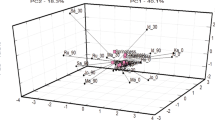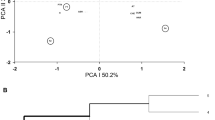Abstract
Internal quality of fresh and cold stored celery petioles of four different accessions (two green cultivars, one yellow cultivar and one yellow local ecotype) was characterised by descriptive analysis of sensory properties of aspect, flavour and texture, chemical determinations (organic acids, sugars, dietary fibre, flavonoids, carotenoids) and instrumental measurements of texture (stiffness, fracture toughness, maximum shear force). In the growing conditions as adopted in the experiment, different genotypes produced petioles with quite similar and low levels of dry matter, but with significant differences in some texture (flexibility, fracturability, hardness, crunchiness and fibrousness), flavour (odour and total flavour) and taste (saltiness and bitterness) attributes. After fortnight of cold storage (2 °C, 75–85% RH) differences between genotypes were still perceived in some texture attributes, particularly flexibility, fracturability and hardness. On the other hand, significant differences were no longer observed in total flavour, whereas lowered differences were still perceived in odour. Green type cultivars distinguished for higher fibrousness, bitter taste and harsh after effect. Sweetness was not linearly correlated to total and individual sugar contents, whereas organic acids content was probably too low to cause perceivable sourness; moreover, the sensory perception of fibrousness during chewing seemed to be related to other constituents in addition to fibre. Finally the low contents of flavones (apigenin 0.76–3.11 mg/kg and luteolin 0.50–1.74 mg/kg) and carotenoids (lutein 0.60–1.58 mg/kg and β-carotene 0.20–0.71 mg/kg) in all genotypes suggested a poor relevance of celery petioles devoid of leaves as dietary sources of these bioactive compounds.


Similar content being viewed by others
References
Gómez PA, Artés F (2004) Postharvest Biol Technol 34:203–209
Gómez PA, Artés F (2004) Eur J Hort Sci 69:215–219
Prakash A, Inthajak P, Huibregtse H, Caporaso F, Foley DM (2000) J Food Sci 65:1070–1075
Fillion L, Kilcast D (2002) Food Qual Preference 13:23–29
Viña SZ, Chaves AR (2003) J Sci Food Agric 83:1308–1314
Alvarez MD, Saunders DEJ, Vincent JFV, Jeronimidis J (2000) J Texture Stud 31:457–473
Wassenhove FA van, Dirinck PJ, Schamp NM, Vulsteke GA (1990) J Agric Food Chem 38:220–226
Martens M (1986) Determining sensory quality of vegetables: a multivariate study. Dr. Agric. Thesis. Agricultural University of Norway, Ås.
Tsao SJJ, Lo HF (2004) Vegetables: types and biology. In: Hui YH, Ghazala S, Graham DM, Murrell KD, Nip WK (eds) Handbook of vegetable preservation and processing. Marcel Dekker Inc., New York, pp 1–22
Salunkhe DK, Desay BB (1984) Celery, lettuce, and endive. In: Postharvest biotechnology of vegetables, vol II. CRC Press, Boca Raton, FL, pp 5–22
Wills R, Mc Glasson B, Graham D, Joyce D (1998) Postharvest. An introduction to the physiology and handling of fruit, vegetables and ornamentals. University of New South Wales Press Ltd, Sydney, pp 230–240
Pantastico EB, Subramanyam H, Bhatti MB, Ali N, Akamine EK (1975) Postharvest physiology: harvest indices. In: Pantastico EB (ed) Postharvest physiology, handling and utilisation of tropical and subtropical fruits and vegetables. AVI Publishing, Westport, CT, pp 77–98
Mozaffarieh M, Sacu S, Wedrich A (2003) Nutr J 2:20–27.
Slattery ML, Benson J, Curtin K, Ma KN, Schaeffer D, Potter JD (2000) Am J Clin Nutr 71:575–582
Hertog MGL, Hollman PCH, Venema DP (1992) J Agric Food Chem 40:1591–1598
Rice-Evans C, Miller NJ, Paganga G (1996) Free Radic Biol Med 20:933–956
AOAC (1995) Method 920.151—solids (total) in fruits and fruits products. In: Horwitz W (ed) AOAC official methods of analysis. AOAC International, Gaithersburg, MD
Brera C (1996) Carboidrati singoli o in miscela. Metodo per HPLC. In: Baldini M, Fabietti F, Giammarioli S, Onori R, Orefice L, Stacchini A (eds) Metodi di analisi utilizzati per il controllo chimico degli alimenti. Istituto Superiore di Sanità, Roma, pp 66–67
Prosky L, Asp NG, Schweizer TF, Devries JW, Furda I (1988) J Assoc Anal Chem 71(5):1017–1023
Raffo A, Paoletti F, Antonelli M (2004) Eur Food Res Technol 219:360–368
Shewfelt R, Henderson J (2003)Acta Hort 604:49–59
Evers AM, Ketoja E, Hägg M, Plaami S, Häkkinen U, Pessala R (1997) Plant Foods Human Nutr 51:173–186
Souci SW, Fachmann W, Kraut H (1994) Food composition and nutrition tables, 5th edn. medpharm Scientific publishers, Stuttgart
US Department of Agriculture, Agricultural research service (2004) USDA nutrient database for standard reference. http://www.nal.usda.gov/fnic/foodcomp/ (Release 17, 2004)
Keller F (1991) New Phytol 117:423–429
Belitz HD, Grosch W (1987) Food chemistry. Springer-Verlag, Berlin, Heidelberg
Plessi M (1995) La Rivista di Scienza dell’Alimentazione 24(1):23–33
Martens M, Baardseth P (1987) Sensory quality. In: Weichmann J (ed) Postharvest physiology of vegetables. Marcel Dekker Inc, New York, pp 427–454
Hermann K (1976) J Food Technol 11:433–448
Crozier A, Lean MEJ, Mc Donald MS, Black C (1997) J Agric Food Chem 45:590–595
Mangels AR, Holden JM, Beecher GR, Forman MR, Lanza E (1993) J Am Diet Assoc 93:284–296
Holland B, Unwin ID, Buss DH (1991) Vegetables, herbs and spices. The composition of foods, 4th edn. The Royal Society of Chemistry, Cambridge
Acknowledgements
This work was a part of the “Qualità Alimentare” programme supported by Ministero per le Politiche Agricole Forestali. Mario Brancaleone (ARSIAL) is especially acknowledged for bringing us into contact with the farm that provided celery samples. We are indebted also to Aldo Bertone for technical assistance.
Author information
Authors and Affiliations
Corresponding author
Rights and permissions
About this article
Cite this article
Raffo, A., Sinesio, F., Moneta, E. et al. Internal quality of fresh and cold stored celery petioles described by sensory profile, chemical and instrumental measurements. Eur Food Res Technol 222, 590–599 (2006). https://doi.org/10.1007/s00217-005-0098-7
Received:
Revised:
Accepted:
Published:
Issue Date:
DOI: https://doi.org/10.1007/s00217-005-0098-7




